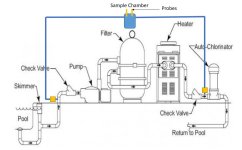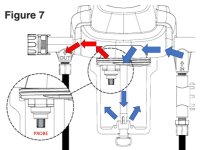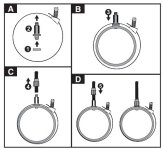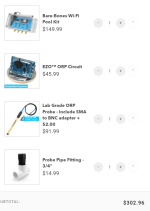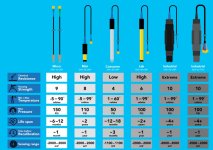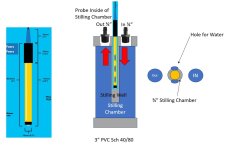I will share a recent email exchange between myself and an Atlas technical support engineer, Jordan. My goal of sharing is to put the information before your expert minds to discern. Remember that engineers may be a bit blunt, but the tone means no offense. I will add any further dialog to this reply.
I want to install ORP and PH monitoring in my pool setup to supplement my TF100 testing. Similar to MyAZPool stated above, for trending. It sounds like a fun project to tackle and is a lot cheaper than more advanced analyzers. I found various PPM chlorine analyzer systems, such as the CH265 PH/Free Chlorine Controller by Chemtrol which cost over $5,000. Sensorex offers a Free Chlorine Sensor for around $1,500 plus the controller and transmitter. There are a number of solutions but cost a lot more money than an ORP system. I understand fully that you get what you pay for. I would like to experiment and find out how I could utilize the numbers that say an Atlas probe provides to monitor the pool. I have been using the TF100 since the opening day of my pool in 2007 and will continue to use it until I fill in the pool.
If I went with a Raspberry PI 5, what parts would I need to connect the Atlas probe to and have wifi? I have never touched or even seen a Raspberry Pi before. I noticed there are various starter kits with pricing from $150 and up. What software would I need to be able to display, log, and transmit the probe data?
My initial email:
|
Good morning,
While surfing the trouble-free website, I noticed that your company was mentioned often. I am searching for a simple, reliable, and repairable monitoring hardware solution —a probe that can report a consistent number. The solution does not need to match the accuracy of the TF100 water test kit; it just has to be consistent. I can monitor daily and do my manual water testing once a week. The hardware is easily replaceable or upgradable. I don't need automation of the pump or valves, and I understand the shortfalls of ORP testing. Over the recent years, pool usage has dropped significantly since the kids have grown and left home, and I have become complacent in my water chemistry. I have been looking at the various ORP gadgets that have entered the market but have avoided them. The pool is a very hostile environment. I prefer solutions that I can repair, which this project offers.
Is there an advantage with going with your bare-bones solution vs building a raspberry Pi solution?
I read that the ENV-40-ORP (Lab) probe had issues with being consistent in its reporting in a pool monitoring setup. Looking at the probe selection guide, it appears the main difference between the Lab and Industrial probes are durability. There is a large price jump from the Lab to an Industrial probe and like most I am trying to limit the cost of this project. Below is one of the postings that I found regarding the Lab probe: "I did lab grades probe for pH and ORP trying to limit cost. The lab grade pH is doing fine but I couldn’t get the lab grade ORP to give reliable, repeatable results—it was all over the place. Maybe a bad probe, idk. I am testing industrial grade ORP now in the hope that it is going to act right."
Thank you so much for taking your time and reading all of this! Any guidance in select the right equipment would be highly welcomed! |
------------------------------------------------------------------------------------------------------------------------------------
Below is Jordan's reply:
Hi Michael,
Monitoring pool water with our equipment is a common application of our technology.
Our probes and electronics are used in many commercial pool monitoring systems.
We also have thousands of customers who have built custom pool monitoring systems, just as you intend to do.
I believe our EZO-Complete product line would be a good fit for you.
It makes building a custom monitoring system quite easy and is far simpler than using a Raspberry Pi.
However, the choice is yours to make.
I do have some concerns with the secondary premise of your email.
Atlas Scientific products are extremely accurate.
This technology was originally developed for the Department of Defense and is used in several military applications for the US Army and Navy.
The probes report the readings they detect.
Your expectation of seeing a consistent number is unrealistic.
Pool water is a highly reactive chemical mixture.
It is common to see changes in the chemical reactivity of pool water.
Our sensors take readings at a default rate of 1 reading per second.
At that speed, you will see chemical reactions occurring that you were previously unaware of.
We know that (in some cases) ORP readings taken from the output pipe of a pool's water filter show unusual chemical reactions.
The reason for these unusual chemical reactions is currently unknown to science.
Although, I believe it has something to do with cavitation occurring inside the pump impeller head.
Using a TF100 water test kit, it is not possible to take readings once per second in a pipe.
So, it is no surprise that "in-pipe reactivity" is unknown to most people.
Thank you for showing the probe selection guide.
That needs to be updated with new info.
Yes, the biggest difference in ORP probes is durability.
This is because ORP probes are extremely basic devices (that are made of VERY expensive parts, unfortunately)
However, our new Gen 3 industrial ORP probe has a very large sensing area.
This makes it far more senstive to change in ORP.
We also have a gold industrial ORP probe that works quite well in pools.
(The gold probe is going up on the website next week)
"Below is one of the postings that I found regarding the Lab probe: "I did lab grades probe for pH and ORP..."
We have thousands of customers, this is one guy.
I bet I already know why he can't solve the issue.
Because the readings are real.
There is a very easy way to tell if the readings are real.
What readings do you get in the calibration solution?
I am certain he gets the correct readings.
Correct readings in the calibration solution but incorrect readings in the pool water?
Not possible.
What is happening is:
Correct readings in the calibration solution but not the readings you want to see in the pool water.
He should move the probe somewhere else in the system.
------------------------------------------------------------------------------------------------------------------------------------
My reply to Jordan:
Good afternoon, Jordan.
Thank you for the excellent reply!
I noticed the EZO Complete, but it needs a direct connection to a computer vs. WIFI or ethernet. Am I correct? I was leaning towards the bare-bones due to the potential of expandability. In the near future, I will probably want to add a PH probe.
Can you share the data sheet and price for the new gold probe?
Would having the probe sample water gathered before the pump aid in any way? I know it’s common to have most pool products attached behind the pump for various reasons. This would aid in eliminating the cavitation. My rough drawing is attached to aid where my technical vocabulary fails.
Taking a further step, I noticed that some products on the market use sampling chambers. Would it be beneficial for the probe to be located in one? Where the water is less turbulent, and the flow is reduced with valves and the pipe size. An example is the Pentair ChemCheck monitoring system. I attached a rough drawing of this device and what appears to be a sampling chamber. The feed tubing is 3/8”, tapped into the pool’s PVC pipes.
Thank you again for your time and sharing your wisdom!
Have a wonderful weekend!
Michael
------------------------------------------------------------------------------------------------------------------------------------
April 24, 2024
Hi Michael,
Yes, the EZO Complete needs a direct connection to a PC.
How you want to set it up is up to you; I'm just making a recommendation.
The price for the new industrial gold ORP probe is $299
The data sheet will be done this week; as soon as it's ready, I can send it your way.
You seem to be designing a slipstream with a probe mounting area.
Nicely done. I suspect that will work quite well.
Dang, that Pentair part is expensive!
I don't think a sampling chamber is needed, but it is nice.
Some water turbulence is fine.
-Jordan
------------------------------------------------------------------------------------------------------------------------------------
April 24, 2024
As I am thinking out how to mount the ORP sensor and I just can't let go of having a stilling chamber, I came up with a simple test using off-the-shelf 3" PVC and various fittings. I can't find anything that I could adapt to house the ORP sensor on the cheap. I found the proper nomenclature for what I have in mind. I would use the lab ORP and the Probe Pipe Fitting - 3/4". I may move the in/out fitting depending on how much space I have at the top next to the probe. The chamber won't be big, 3" wide by about 8" to 12" long. I will accept laughter at my PowerPoint drawing!

(See attachment)
My plan is to test the probe in various spots:
- In the above chamber
- In the pool skimmer
- In the traditional PVC pipe setup.
Then compare notes and see if it adds value to my water quality monitoring.
Thank you for taking the time to deal with me!! I appreciate your input and guidance.
Michael


